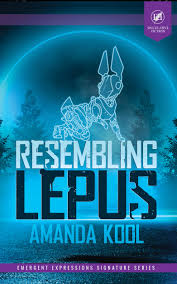 Amanda Kool’s Resembling Lepus is a startling new mystery sci-fi novel created by an up and coming author in the genre.
Amanda Kool’s Resembling Lepus is a startling new mystery sci-fi novel created by an up and coming author in the genre.
The story opens with a detective looking in on a crime scene, and it is brilliantly written and how familiar yet alien it is. The crime scene, decked out in full procedural trappings, is for a dead rabbit. While yes the rabbit has been killed, and by human hand it seems, the fact that these measures are taken over a rabbit illustrate just how different the world has become.
This is a post-post-apocalyptic story, dealing with a society that has had to rebuild from a startling level of extinction. As such the death of a rabbit, real like in this or artificial like so many others about, is seen as murder.
The mix of a post apocalyptic setting with the grizzled detective is nothing new, yet Kool spends much time helping the reader to understand how precious animal life is considered in this new world. From food rationing to difficult attempts at cleaning and repopulating the animal kingdom one can see the new technology. Yet human desires for something they can feel, for justice vengence or belonging, seem all the more real for these changes. Indeed the combined changing and similarity of this world is nowhere more obvious than the creation of an impromptu shrine of letters, posters, tributes, and even a stuffed animal when a rabbit has died.
The internal politicking in law enforcement is touched upon, although the details of it are more benign than in most current day mysteries.
Questions of memory and identity are key to this book in a way it might not in any similar non science fiction volume. Indeed, as good as the world-building is in the text it is these themes help to remind a reader of the qualities which are brought to the front in this world.
My copy has a typo on page 12, where the word or substitutes for the word our when the phrase is clearly supposed to be “our own.” Past that the copyediting and proofreading in the volume is high quality, always a nice surprise in small press publications.
There is a large amount of back matter in this volume. That includes advertisements for other books from the publisher, as well as a long sample of Natasha Loves Slayer by Matthew R. Davis. In and of themselves these might be without notice, however they have an interesting effect when reading the book in a physical form. Normally in a mystery one can guess based on the length of the volume when a solution is accurate, but this little bit of bulking out keeps the reader guessing.
Resembling Lepus is an excellent example of what can be done with a science fiction mystery. The very nature of the mystery lends itself to the setting and the oddities that exist within it. By a similar token any detail of the setting and world can easily seem important or flavorful, yet easily feed into the solution to the murder. A mystery like this comes along rarely, readers should enjoy it greedily and treasure every word.
(Grey Matter Press 2022)
